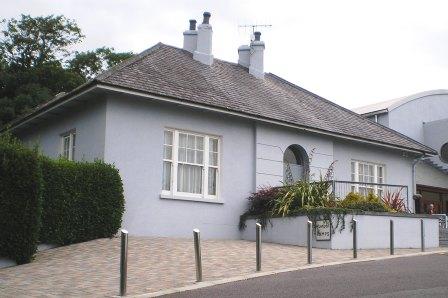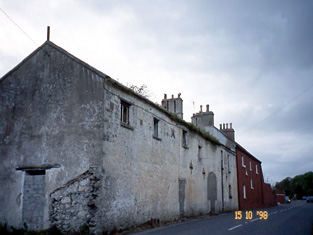Frogmore
Houses within 5km of this house
Displaying 20 houses.
Houses within 5km of Frogmore
Displaying 20 houses.
| House name | Description | |
|---|---|---|
| Mount St. Annagh | St. John Mason was leasing this property to Johanna O'Connor at the time of Griffith's Valuation, when the house, valued at £3 10s, stood on 800 acres. Johanna O'Connor was one of the principal lessors in the parish of Annagh at that time. The original house is no longer extant. | |
| Ballyard House | At the time of Griffith's Valuation, Francis Crosbie was leasing Ballyard House from Reverend Arthur Rowan, when it was valued at £35. The Colthurst Estate sale notice of 1856 notes that Thompson leased the property from Nicholas Colthurst in the 1820s and that A.B. Rowan was an assignee of Thompson. Bary states that this house was possibly re-modelled by Peter Thompson in the late 1820s. |

|
| Ballyard | The representatives of Peter Foley were leasing a property at Ballyard to Margaret Crosbie at the time of Griffith's Valuation, when it was valued at £30. Lewis records Ballard as the seat of Francis Crosbie in 1837. | |
| Ballyard B | Geoffrey Eager was leasing a property to Patrick Ryan at the time of Griffith's Valuation, when it was valued at £15. | |
| West Villa or West Lodge | Edward Mulchinock was leasing this property from Sir George Colthurst at the time of Griffith's Valuation when it was valued at £15. Bary writes that this is the house associated with William Mulchinock, the writer of the famous song "The Rose of Tralee". It is still extant and occupied. | |
| Spring Lodge | Rev. Arthur Rowan was leasing this property to Robert Bell at the time of Griffith's Valuation, when it was valued at £15. Lewis records Spring Lodge as the residence of F.J. Martelli in 1837. Bary states that this is another of the houses built by Peter Thompson in the 1820s. Rowan was married to his daughter Alicia and they lived at nearby Belmont. Spring Lodge is still extant. | |
| Lohercannon House | Catherine Day was leasing this property to Richard Murphy at the time of Griffith's Valuation when it was valued at £15. In 1786 Wilson refers to "Lower-cannon" as "formerly the seat of Rev. Mr. Day, accidentally destroyed by fire". The Ordnance Survey Name Books describe it as the seat of Edward Orpen but originally built by the Day family. Lohercannan is referred to in the Irish Tourist Association Survey of the 1940s as "another building that would be worht a visit".The second house also seems to have been held by the Days but leased out to other families including the Morrises and Eagers. It was demolished to make way for housing in the 1960s. | |
| Ballyroe Lodge | Sir Edward Denny was leasing this property to Pierce Chute at the time of Griffith's Valuation when it was valued at £17 15s. Bary writes that it was built by Pierce Chute, possibly in 1836, according to O'Donovan. The Chutes continued in residence until the late nineteenth century after which it had a succession of owners. It now forms part of the Ballyroe Heights Hotel complex. |

|
| Listrim House | Sir Edward Denny was leasing Listrim House to Robert Fortune at the time of Griffith's Valuation, when it was valued at £12 10s. In the 1830s the Ordnance Survey Name Books record that it was the residence of Henry Oliver by whom it was supposedly erected in 1836. It is now a ruin. | |
| Lisadale Lodge | John Busteed was leasing Lisadale Lodge from William Howard at the time of Griffith's Valuation, when it was valued at £6 10s. The Ordnance Survey Name Books record it as the residence of William Howard, by whom it was supposedly built, in 1836. Bary writes that the house may have been a hunting lodge. It is now ruinous. | |
| Ballygarran House | Sir Edward Denny was the lessor of Ballygarran at the time of Griffith's Valuation, when the property, valued at £9 10s, was vacant. In the 1830s, the Ordnance Survey Field Name Books mention Ballygarran House as the residence of William Hilliard by whose family it had been built in the eighteenth century. It is described as " an oblong low thatched house". Bary notes that it was a house frequently associated with the Hilliard and later the Fitzmaurice families. It was demolished in the mid-twentieth century. | |
| Lassinah | John Day Stokes was leasing this property from Sir Edward Denny at the time of Griffith's Valuation, when it was valued at £20 10s. Bary states that Major Stokes retired here from his Indian Army post and renovated the house where he lived until 1862. It remained in the Stokes family until the end of the nineteenth century and was recorded by Slater as the seat of Maj. Oliver R. Stokes in 1894. It is still extant but ruined. | |
| Kent Lodge | Richard O'Connell was leasing this property from the Denny estate at the time of Griffith's Valuation, when it was valued at £10 10s. Bary states that this house was attached to an earlier building known as O'Connell's Cottage where Rickard O'Connell lived but that Kent Lodge was built by William Collis. The house, which is still extant, remained in the Collis family until the early twentieth century. |

|
| Church Hill House | At the time of Griffith's Valuation, Rev. Henry Denny was leasing Church Hill from Sir Edward Denny when it was valued at £27. According to Bary the house was in the hands of the Denny family for much of the eighteenth and nineteenth centuries until it passed to the Neligans, possibly in the 1880s. In 1906 it was owned by William Neligan and valued at £27. It is still extant and occupied. |

|
| Plover Hill House | Sir Edward Denny was leasing this property to George Gunn at the time of Griffith's Valuaton, when it was valued at £16 5s. Lewis records it as the seat of George Gun in 1837. Bary states that the house was built in the early nineteenth century by Barry-William Gun, whose mother was Arabella Denny. The Gunn family continued to own the property until the 1880s. Buildings still exist at the site. | |
| Curragh | William John Neligan was leasing this property from the Denny estate at the time of Griffith's Valuation, when it was valued at £8 10s. Bary indicates that the house has always been occupied by merchant families from Tralee. It is still extant. | |
| Oyster Hall | Edward Denny was leasing this property to William J. Neligan at the time of Griffith's Valuation, when it was valued at £18 Lewis refers to it as the seat of Barry Collins while Oyster Lodge was the residence of Mr.Neligan in 1837. IIn the 1830s, the Ordnance Survey Field Name Books mention Oyster Hall as the seat of Daniel Supple but originally built by George Rowan in 1804. In 1814, Leet refers to Oyster Hall as the residence of George Rowan. Bary states that Oyster Hall was orginally built by the Rowans but was associated with the Neligans by the middle of the nineteenth century. It is no longer extant. | |
| Mount Hawk | In 1906 Mounthawk was owned by Elizabeth Stokes and valued at £18 5s. The townland was in the possession of George Stokes at the time of Griffith's Valuation. Bary states that it was built by George Stokes on lands purchased from the McCarthy family and remained in the Stokes family well into the twentieth century. It was later used as a clubhouse by Tralee Golf Club. | |
| Tralee | At the time of Griffith's Valuation, Francis Crumpe was leasing a property, valued at £31, at Denny St., Tralee, from John Donovan. [Grid Reference is approximate]. | |
| Tralee Castle | In 1786 Wilson writes "at Tralee is a castle in tolerable preservation, formerly one of the castles of the Earls of Desmond, granted by Queen Elizabeth to Sir Anthony Denny, and now the seat of his descendent, Sir Barry Denny". In 1943 the Irish Tourist Association Survey mentions that the last reconstruction of the building occurred in 1802. Bary writes that, after the Act of Union, the Denny family spent more time in England and the castle fell out of use and was eventually demolished and the stones used for other buildings. |

